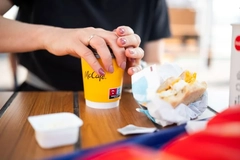
- Industry news
Industry news
- Category news
- Reports
- Key trends
- Multimedia
Multimedia
- Journal
- Events
- Suppliers
Suppliers
- Home
- Industry news
Industry news
- Category news
- Reports
- Key trends
- Multimedia
Multimedia
- Events
- Suppliers
Suppliers
New Amazon Echo, Kindle and Fire TV packaging to use more recycled fiber and less ink
Amazon’s new packaging for Echo, Kindle and Fire TV packaging uses more recycled fiber and less ink than its previous applications. The redesign aims to improve the circularity of Amazon packaging by increasing its recycled content and using 60% less ink while aiming to reduce reliance on non-renewable materials. It is also increasing its QR code use to reduce paper.
“Our new packaging introduces, on average, 30% more recycled fiber content, reducing the reliance on virgin tree-based and bleached fibers,” says Maiken Moeller-Hansen, director of Energy and Sustainability at Amazon Devices and Services.
“That means that we’re using more fiber content that’s already been recycled by customers and is in circulation. Across our device product lines, we average 98% wood fiber-based materials in our packaging.”
The packaging is designed to look like the standard Amazon brown kraft box design “that Amazon customers are already familiar with because we aren’t bleaching our boxes.”
The chemicals used to bleach carton packaging can be harmful to the environment and the process tends to be carbon-intensive.
The brown kraft packaging also more than doubles the amount of post-consumer recycled materials used by the company.
Accessible product information
Amazon already uses QR codes that customers scan to get more detailed setup instructions and reduce the amount of paper in the box. Now, it is taking this concept further with a new tactile-marked QR code that will now be used on Quick Start Guides in Amazon boxes.
Moeller-Hansen explains that this step facilitated customer accessibility, as those who are blind or have low vision can easily find the code by touch and scan it to access a digital quick-start guide. The guide details product information, setup instructions, troubleshooting tips and to learn more about the device’s accessibility features.
The change will apply to select Amazon device packages, and it will be expanded to all packaging over time.
 The new Echo, Kindle and Fire TV packaging uses more recycled fiber and less ink.Boosting packaging sustainability
The new Echo, Kindle and Fire TV packaging uses more recycled fiber and less ink.Boosting packaging sustainability
Amazon has taken several steps to improve the sustainability of its packaging over the past year, including removing packing pillows (the largest plastic reduction in North America) and introducing its shock-absorbing lightweight paper mailers as a bubble wrap alternative, alongside Mondi.
“Over the past few years, we’ve made a number of changes to make our device packaging even more recyclable — in fact, last year, 90% of the devices we launched in the US were boxed in 100% recyclable device packaging,” says Moeller-Hansen.
“One of the key changes we made was removing the plastic bags in and outside the box. Originally, we used outer plastic wraps and laminations to properly protect the box from damage when it was shipped, which we’ve replaced with a water-based coating that keeps that box safe and undamaged. Inside the box, we’re using paper-based wraps that protect the device and are compatible with paper recycling streams.”
Amazon introduced changes to its shipping of devices to warehouses to decarbonize its transportation network and meet its 2040 “The Climate Pledge.”
“For example, we’ve continued to find ways to make our device boxing more compact when possible, which lets us increase how many products go on a pallet. Plus, we’ve focused on using more non-air modes of transportation when we ship products from final assembly to our warehouses.”
Amazon’s science models show that ocean shipping emissions are, on average, 95% lower than air transport emissions.
The company’s latest holiday season consumer survey revealed a major interest in sustainable packaging among US consumers. We discussed these findings and their implications with Pat Lindner, vice president of Mechatronics and Sustainable Packaging at Amazon.












